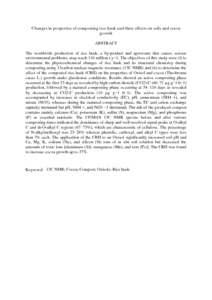Citation
Anda, Markus and Syed Rastan, Syed Omar and Jusop, Shamsuddin and Ishak, Che Fauziah
(2008)
Changes in properties of composting rice husk and their effects on soils and cocoa growth.
Communications in Soil Science and Plant Analysis, 39 (15-16).
pp. 2221-2249.
ISSN 0010-3624; ESSN:1532-2416
Abstract
The worldwide production of rice husk, a by‐product and agrowaste that causes serious environmental problems, may reach 116 million t y−1. The objectives of this study were (i) to determine the physicochemical changes of rice husk and its structural chemistry during composting using 13carbon nuclear magnetic resonance (13C NMR) and (ii) to determine the effect of the composted rice husk (CRH) on the properties of Oxisol and cocoa (Theobroma cacao L.) growth under glasshouse conditions. Results showed an active composting phase occurred at the first 53 days as revealed by high carbon dioxide (CO2)‐C (40–71 µg g−1 h−1) production, followed by a matured composting phase occurring at 54–116 days as revealed by decreasing in CO2‐C production (10 µg g−1 h−1). The active composting was accompanied by increases in electrical conductivity (EC), pH, ammonium (NH4 +), and nitrate (NO3), whereas during the matured composting phase, the EC and cation exchange capacity increased but pH, NH4 +, and NO3 −1 decreased. The ash of the produced compost contains mainly calcium (Ca), potassium (K), sulfur (S), magnesium (Mg), and phosphorus (P) as essential nutrients. The CP/MAS 13C NMR spectra before and after various composting times indicated the dominance of sharp and well‐resolved signal peaks at O‐alkyl C and di‐O‐alkyl C regions (67–73%), which are characteristic of cellulose. The percentage of N‐alky/methoxyl was 23–26% whereas phenolic, carboxyl, and alkyl C types were less than 3% each. The application of the CRH to an Oxisol significantly increased soil pH and Ca, Mg, K, sodium (Na), and silicon (Si) ions of in situ soil solution but decreased the amounts of toxic ions [aluminum (Al), manganese (Mn), and iron (Fe)]. The CRH was found to increase cocoa growth up to 37%.
Download File
![[img]](http://psasir.upm.edu.my/13515/1.hassmallThumbnailVersion/Changes%20in%20properties%20of%20composting%20rice%20husk%20and%20their%20effects%20on%20soils%20and%20cocoa%20growth.pdf)  Preview |
|
PDF (Abstract)
Changes in properties of composting rice husk and their effects on soils and cocoa growth.pdf
Download (297kB)
| Preview
|
|
Additional Metadata
Actions (login required)
 |
View Item |

